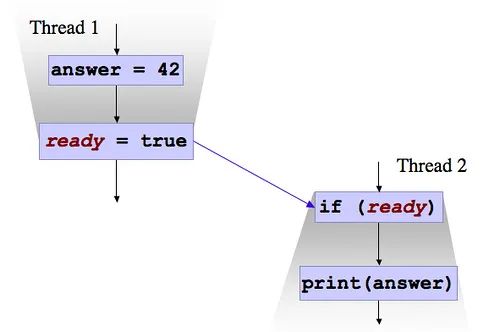简介
volatile关键字保证了在多线程环境下,被修饰的变量在别修改后会马上同步到主存,这样该线程对这个变量的修改就是对所有其他线程可见的,其他线程能够马上读到这个修改后值。
Thread的本地内存
- 每个Thread都拥有自己的线程存储空间
-
例子

借用Google JEREMY MANSON 的解释,上图表示两个线程并发执行,而且代码顺序上为Thread1->Thread21. 不用
volatile假如
ready字段不使用volatile,那么Thread 1对ready做出的修改对于Thread2来说未必是可见的,是否可见是不确定的。假如此时thread1 ready泄露了(leak through)了,那么Thread 2可以看见ready为true,但是有可能answer的改变并没有泄露,则thread2有可能会输出 0 (answer=42对thread2并不可见)2. 使用
volatile使用
volatile以后,做了如下事情 每次修改
volatile变量都会同步到主存中- 每次读取
volatile变量的值都强制从主存读取最新的值(强制JVM不可优化volatile变量,如JVM优化后变量读取会使用cpu缓存而不从主存中读取) - 线程 A 中写入
volatile变量之前可见的变量,在线程 B 中读取该volatile变量以后,线程 B 对其他在 A 中的可见变量也可见。换句话说,写volatile类似于退出同步块,而读取volatile类似于进入同步块
所以如果使用了volatile,那么Thread2读取到的值为read=>true,answer=>42,当然使用volatile的同时也会增加性能开销
注意
volatile并不能保证非源自性操作的多线程安全问题得到解决,volatile解决的是多线程间共享变量的可见性问题,而例如多线程的i++,++i,依然还是会存在多线程问题,它是无法解决了。如下:
使用一个线程i++,另一个i—,最终得到的结果不为0
public class VolatileTest {private static volatile int count = 0;private static final int times = Integer.MAX_VALUE;public static void main(String[] args) {long curTime = System.nanoTime();Thread decThread = new DecThread();decThread.start();// 使用run()来运行结果为0,原因是单线程执行不会有线程安全问题// new DecThread().run();System.out.println("Start thread: " + Thread.currentThread() + " i++");for (int i = 0; i < times; i++) {count++;}System.out.println("End thread: " + Thread.currentThread() + " i--");// 等待decThread结束while (decThread.isAlive());long duration = System.nanoTime() - curTime;System.out.println("Result: " + count);System.out.format("Duration: %.2fs\n", duration / 1.0e9);}private static class DecThread extends Thread {@Overridepublic void run() {System.out.println("Start thread: " + Thread.currentThread() + " i--");for (int i = 0; i < times; i++) {count--;}System.out.println("End thread: " + Thread.currentThread() + " i--");}}}
最后输出的结果是
Start thread: Thread[main,5,main] i++ Start thread: Thread[Thread-0,5,main] i-- End thread: Thread[main,5,main] i-- End thread: Thread[Thread-0,5,main] i-- Result: -460370604 Duration: 67.37s
原因是i++和++i并非原子操作,若查看字节码,会发现
void f1() { i++; }
的字节码如下
void f1();Code:0: aload_01: dup2: getfield #2; //Field i:I5: iconst_16: iadd7: putfield #2; //Field i:I10: return
可见i++执行了多部操作,从变量i中读取读取i的值 -> 值+1 -> 将+1后的值写回i中,这样在多线程的时候执行情况就类似如下了
Thread1 Thread2r1 = i; r3 = i;r2 = r1 + 1; r4 = r3 + 1;i = r2; i = r4;
这样会造成的问题就是 r1,r3读到的值都是 0,最后两个线程都将 1 写入 i,最后 i 等于 1,但是却进行了两次自增操作
可知加了volatile和没加volatile都无法解决非原子操作的线程同步问题
线程同步问题的解决
Java提供了java.util.concurrent.atomic 包来提供线程安全的基本类型包装类,例子如下
import java.util.concurrent.atomic.AtomicInteger;public class SafeTest {private static AtomicInteger count = new AtomicInteger(0);private static final int times = Integer.MAX_VALUE;public static void main(String[] args) {long curTime = System.nanoTime();Thread decThread = new DecThread();decThread.start();// 使用run()来运行结果为0,原因是单线程执行不会有线程安全问题// new DecThread().run();System.out.println("Start thread: " + Thread.currentThread() + " i++");for (int i = 0; i < times; i++) {count.incrementAndGet();}// 等待decThread结束while (decThread.isAlive());long duration = System.nanoTime() - curTime;System.out.println("Result: " + count);System.out.format("Duration: %.2f\n", duration / 1.0e9);}private static class DecThread extends Thread {@Overridepublic void run() {System.out.println("Start thread: " + Thread.currentThread() + " i--");for (int i = 0; i < times; i++) {count.decrementAndGet();}System.out.println("End thread: " + Thread.currentThread() + " i--");}}}
输出
Start thread: Thread[main,5,main] i++ Start thread: Thread[Thread-0,5,main] i-- End thread: Thread[Thread-0,5,main] i-- Result: 0 Duration: 105.15
结论
volatile解决了线程间共享变量的可见性问题- 使用
volatile会增加性能开销 volatile并不能解决线程同步问题- 解决i++或者++i这样的线程同步问题需要使用
synchronized或者AtomicXX系列的包装类,同时也会增加性能开销

